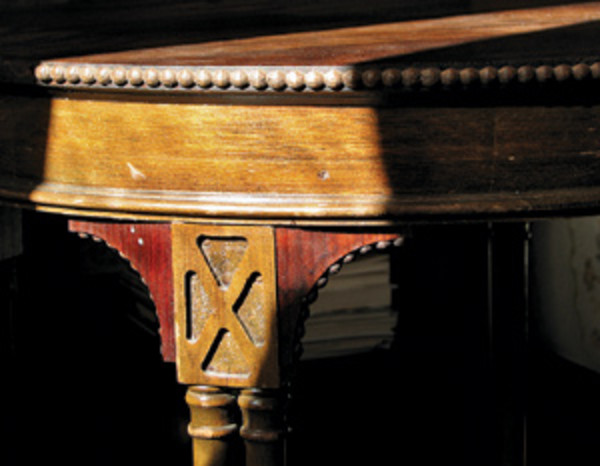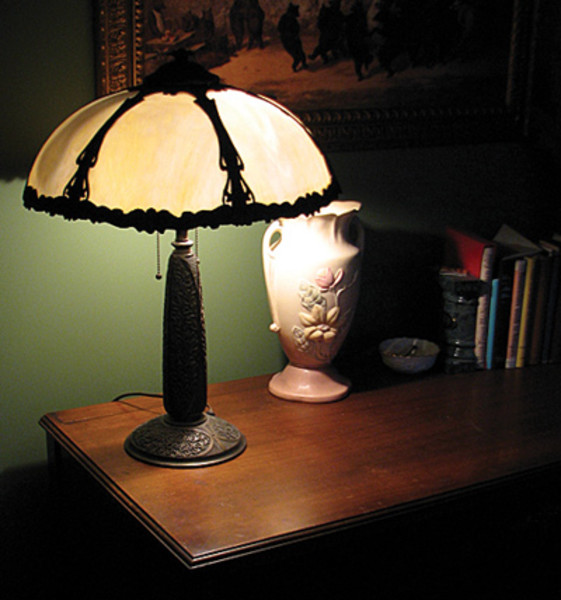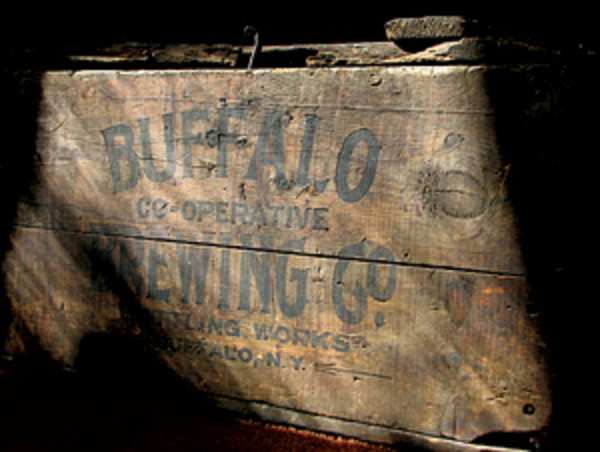The simple circle top and graceful, double-columned legs of this occasional table (purchased for $35) make it perfect for our library, where it sits next to a wing chair and gets lots of use as a handy spot for tea and books.
Unless you’re lucky enough to have inherited an ancestral home chockablock with priceless antiques (in which case I don’t want to talk to you), you know this feeling: the uh-oh sensation that kicks in when you sign the closing papers and wave goodbye to the moving vans.
How, you think as you survey the house you’ve just bought, I ever going to furnish this place?
Old houses (like my Victorian) are big. Old houses may have lots of rooms. Those rooms have weird dimensions and odd shapes and interior spaces that are either cavernous or tiny and not easily furnished. Take it from one who knows: My 1898 Queen Anne has four big bedrooms with narrow doorways opening off a narrower hall (no couches upstairs here!), two miniscule bathrooms, and an ironing room. Yes, you read that right. Ironing. I dare you to try decorating that kind of space with things you find at the mall.
Secret Weapon
I found that there’s a secret weapon available in the quest to furnish a vintage home without breaking the bank or sacrificing your sanity—and without settling for generic furniture, wall art, light fixtures, and decorative objects. That secret weapon is the live auction.
Don’t be intimidated: Today’s auctions aren’t stuffy, overbearing pavilions of bad taste and ruthless competition. (At least most of them aren’t.) Think of them more as a combination of your favorite antiques boutique and your local Goodwill. Live auctions are growing more and more popular, too—total gross revenues across the country in 2007 totaled $270.7 billion, according to the National Auctioneers Association, a figure that jumped 5.3 percent from the year before and which has been increasing steadily over the past decade.
What can be found at auction? How about vintage chandeliers, antique hand-woven rugs, marble-topped tables, writing desks and highboys and chifforobes and immigrant trunks? Plus any sort of item of daily life from all periods, from butter churns to Beatles trading cards to Fiestaware pitchers.
All you need is the spirit to give it a try—and guidance to help you through your first auction experience. Demystify the process and you’ll have fun and score some cool stuff for your vintage home. Trust me: There is nothing like making off with a glass-fronted, turn-of-the-century barrister’s bookcase for $60 to get your blood racing.
Attend one auction using the following tips, and you’ll return again and again. That old house will be full in no time at all. The best part is, every piece is guaranteed to come with a story—the story of how you found it at auction.
8 Tips for a Successful Auction Outing
1. Locate an auction near you. Try asking other old-house owners if they know of such a place; you might even form a small group to check one out together. (See #6 tip.) Your local newspaper also likely carries listings about upcoming auctions; read the classifieds to find them. Or, for a shortcut, visit the website of the National Auctioneers Association (auctioneers.org), which lets you search for live auctions by date, by the category of item you want to find (“antiques,” for instance), or geographically, by entering your town or ZIP code. The user-friendly NAA website even provides auction lists and photographs of the items for some of these events. Another useful web site to try: auctionnetwork.com.
We wanted a slag-glass lamp forever, but in antique lamp stores they were always $500 to $1,000, way out of our price range. This one, which we got for $80, has one chipped glass panel, easily hidden by turning it to the wall. It’s a beautiful shape: elegantly Victorian, as opposed to overwrought.
2. Start with a low-key environment. Your goal is to find a place that’s low-stress and welcoming to newcomers. Luckily, that describes many auction houses nowadays, as auctioneers try to make their events as public-friendly as possible. “We’ve learned to tone it down. Don’t worry, you won’t bid on something by scratching your nose!” says Steve Phillips of the Lodge Auction House in Buffalo, New York (thelodgeauction.com), who greets new bidders with a wide smile and a rousing “Welcome to the auction!” Look for a place that makes a pre-printed list of items to be auctioned available, either beforehand on the web or at the door.
3. Know your limits. Before you even walk through the door, know how much you are willing to spend to get your feet wet. Twenty dollars? Two hundred dollars? Either is fine, because most auctions open to the general public have items in a wide range of prices. (But be sure to check the auction list to make sure that’s the case.) Once you decide on a limit, stick to it. It’s easy to get carried away during the proceedings, especially as a newbie. Don’t become a cautionary tale by bidding a thousand bucks on a set of Betty Boop drinking glasses that your Aunt Hilda used to have. (Even if you have loads of disposable cash and really, really want them, be sure they fit within your pre-set limit.)
4. Go in prepared. Once you get into the swing of the auction, you won’t want to leave. Although some events boast snack bars, it’s better to bring a granola bar and bottle of water. Other musts: a notebook with the measurements of all rooms, doorways, windows, and walls in your house that you might want to furnish; a tape measure, so you can check any tempting pieces for size; a pen or two; your checkbook and credit card, in addition to cash; and a cell phone. Also pack bubble wrap and boxes or bags if you plan to buy anything delicate or hard to carry.
5. Check out items before the bidding starts. Most auctions will let you do that in a specified period before the bid-calling begins; some, like the Lodge in Buffalo, even set aside a separate day earlier in the week for interested potential bidders to inspect the items up close. “People can come in a look at things, go home and do their research, and then come back and bid,” says Phillips. The best auctions will want you to be as educated and empowered as possible when the bidding begins—but in the end, the responsibility lies with you. At an auction, it’s caveat emptor: buyer beware. “Once you bid on it, it’s yours,” says Chris Longly at the NAA, which represents more than 6,000 auctioneers and is based in Overland Park, Kansas. “You can’t come back and say, ‘Look, there’s a scratch on this.’ Ninety-nine percent of auctions have an ‘as is–where is’ clause, no contingencies and no warranties. So you need to do your homework.
6. Take a gut-check friend. This one is self-explanatory. Besides making the outing itself more enjoyable, having a friend or family member along gives you a second opinion on potential purchases, and can remind you about your spending limits in the heat of the moment. Take someone with a level head and common sense; then, when they tell you don’t need that 14-box collection of Doris Day memorabilia, listen.
At our first auction, my husband spotted a crate from the defunct Buffalo Co-Operative Brewing Company (1880 to 1920). We got it for a song ($15), and it’s the perfect size to store chargers and cords for our electronic equipment.
7. Ask to hear the ground rules. Most auctions operate on the same basic principles, according to the same basic rules. “Auctions are about turning assets into cash, rapidly,” says Longly. Expect things to move quickly, at least until you get used to the sound and feel of it. Ask for a list of auction rules and conditions. Don’t be intimidated by the auctioneer’s chant, which is just a call-and-response singsong meant to entertain the audience and move the goods along as quickly as possible. If you want to master the basic terms you’ll be hearing, go to the NAA web site and click on the glossary page, or check out the Complete Idiot’s Guide to Live Auctions, a 352-page guidebook published by the NAA and available for $17.
8. Drive a truck or suv. Just in case. You might go in wanting a set of 1940s-era Jadite bakeware and then spot the vintage Hoosier cabinet that will finish the kitchen. That’s not gonna fit in your purse. Go prepared. You probably have to leave with everything you buy; later pick-ups often aren’t allowed. Learn from me: the day you drive your sister’s Yugo to auction is the day you spot the armoire of your dreams.







